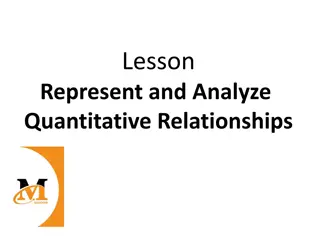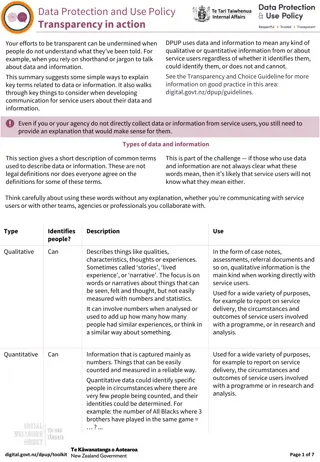“Quantitative Data Analysis for Development - NEC Conference 2019 Overview”
Explore the key modules of the National Evaluation Capacities Conference 2019 focusing on quantitative data analysis for development. Covering topics such as basic concepts, summary statistics, bivariate analysis, hypothesis testing, data visualization, and the effective use of dummy tables in evaluation work. Learn about the purpose and utility of dummy tables, their types, and how they contribute to systematic analysis and decision-making in development evaluations.
Download Presentation

Please find below an Image/Link to download the presentation.
The content on the website is provided AS IS for your information and personal use only. It may not be sold, licensed, or shared on other websites without obtaining consent from the author. Download presentation by click this link. If you encounter any issues during the download, it is possible that the publisher has removed the file from their server.
E N D
Presentation Transcript
Quantitative Data Analysis For Development Evaluatation National Evaluation Capacities (NEC) Conference 2019 No One Left Behind Hurghada, Egypt October 20-24, 2019. Bassirou Chitou, Ph. D.
Module I: Basic Concepts Module II: Summary Statistics Essentials Presentation Outline Module III: Bivariate Analysis and Hypothesis Testing Module IV: Data Visualization Basics
Module I Module I Basic Concepts and Dummy Tables
Basic concepts Basic concepts What are the evaluation questions (EQ)? What are the evaluation hypothesis (EH)? What is the main outcome (s) ? What are the covariates?
Dummy Table: Definition and Example Dummy Table: Definition and Example Definition Example blank mock tables , or blank table shells ; variable names; labels of statistical measures; absolutely NO data; constructed before data collection Table I: Participants Sociodemographic Traits Sociodemographic Characteristics n Percent (%) Gender Male Total
How Useful Are Dummy Tables? How Useful Are Dummy Tables? Template for systematic steps in the analysis Ensure correct data were collected help to visualize the data in relationship to the evaluation overall goal help you test the evaluation hypotheses True Merits of Dummy Tables help you stay focused on relevant analyses powerful communication tool Advance planning tool for various analysis centralized record of analyses, results, and decisions
Basic Types of Dummy Tables Basic Types of Dummy Tables Table of participants baseline socio-demographic characteristics; Table of bi-variate analysis of main outcome and key covariate(s); Table of subgroup analysis, for example, male vs. female; Table of regression analysis or other models building.
Go to https://d.docs.live.net/43296abb124de8a9/Documents/UNDP_Egypt/workshop/word https://d.docs.live.net/43296abb124de8a9/Documents/UNDP_Egypt/workshop/word /nss_sam_dummy_tables_oct_21_2019.docx /nss_sam_dummy_tables_oct_21_2019.docx
How Do We Analyze Data Effectively? Step 1: Prepare the data Step 2: Describe your sample Step 3: Assess Difference and Significance Data Analysis Steps Step 4: Explore relationships Step 5: Built meaningful models Step 6: Organize and Present Findings Step 7: Validate Findings with Key Stakeholders
Data Analysis Planning Worksheet (DAP) Data Analysis Planning Worksheet (DAP) DAP Worksheet Template DAP Features good communication tool; help secure the necessary resources; ensure your accountability. Resources What you have What you need How to get what you need or work within resources limitation Funding Time Staff Materials and equipment
Module II Module II Descriptive Analysis: Summary Statistics
Level Of Measurement Level Of Measurement Definition scale that defines and identifies a given variable; Six Types of Level Of Measurement Binary; Nominal; Ordinal; Interval; Ratio; Likert scale determines the appropriateness and the use of a certain statistical method.
Binary and Nominal Variable Binary and Nominal Variable Binary 2 unique values or categories; Puts each unit in one and only category Sex: male / female Did you eat today: yes / no Nominal 2 or more distinct categories or classes; puts each unit in one and only one category; marital status: single / married /separated/divorced/widowed
Interval and Ratio Interval and Ratio Interval difference or interval makes sense; division or ratio does NOT; 0 does NOT mean Absence ; Example: Temperature Ratio BOTH difference and ratio make perfect sense; 0 = ABSENCE; Example: Age, height, income, revenue.
Likert Scales Likert Scales Agreement Scale Measure respondent s opinion on a particular topic; Extent to which participant agrees or disagrees ; Extent of which a respondent is satisfied or dissatisfied ; Rating / Ranking Ask participant to rate or rank a particular statement; On a scale of 1 to 5 how would you rate the WFP Food Assistance you received in the past 3 months
Importance of Level of Scale Importance of Level of Scale The scale of measurement determines the correct statistical analysis; The inferences or conclusions that may or not be drawn
Measure of Central Tendency Measure of Central Tendency Single value describes center of the data; Characterizes typical behavior of the data; facilitates comparisons between data.
Measures of Central Tendency Measures of Central Tendency Mean: Arithmetic average; Easy to use; Most popular. Symmetric distribution Affected by extreme values: NOT robust Mode: Most Frequent value; Highest Frequency value; Skewed distribution Robust against extreme values Central Tendency Measures Median: Ordered data; Middle value Skewed distribution. Robust against extreme values
Measure of Variation Measure of Variation Describes the extent to which the data is spread out, stretched or squeezed around the central tendency value. Characterizes dispersion of the data; Help understand how individual scores or values behaves; enhances comparisons between data.
Measures of Central Tendency Measures of Central Tendency Standard Deviation (SD): Describes how far or close a value is from the mean; Square root of the variance; Small is good; Large is of concern Measures Of Variation Interquartile Range (IQR): Difference between Third Quartile (Q3) and First Quartile Q1; Contains approximately 50% of the data. Coefficient of Variation (CV): ?? = ????; expressed as %; The higher the CV, the greater the dispersion; The lower CV, the more precise the estimate; used to compare 2 different surveys; compare variability between 2 distributions. ??
Module III Module III Bivariate Analysis & Hypothesis Testing
Go to https://d.docs.live.net/43296abb124de8a9/Documents/UNDP_Egypt/workshop/word https://d.docs.live.net/43296abb124de8a9/Documents/UNDP_Egypt/workshop/word /intro_to_quant_anal_undp_nec_2019_sept_26_2019.docx /intro_to_quant_anal_undp_nec_2019_sept_26_2019.docx
Module IV Module IV Bivariate Analysis & Hypothesis Testing
Go to https://d.docs.live.net/43296abb124de8a9/Docu ments/UNDP_Egypt/workshop/word/intro_to_qua nt_anal_undp_nec_2019_sept_26_2019.docx























